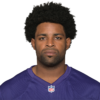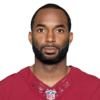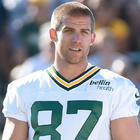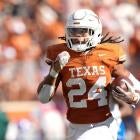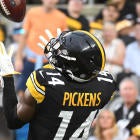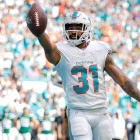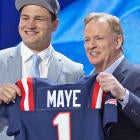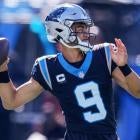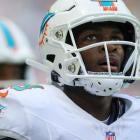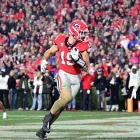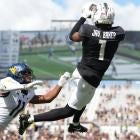There isn't an outstanding track record of receivers changing teams via free agency and becoming Fantasy Football studs. Alshon Jeffery was last year's lone example of a wideout landing a large contract and being useful on a meaningful basis. Rishard Matthews did it in 2016 and Eric Decker and Jeremy Maclin were solid after inking deals with new clubs in 2015.
That track record will get tested in 2017. Several prominent pass catchers changed teams this offseason in hopes of finding success. Fantasy owners can only hope their moves leads to great stats. Here's our reaction to the many moves made by money men in March.
Crabtree landed on his feet by signing with the Ravens and will likely serve as their No. 1 receiver. That's a better role than he would have had if he stayed with the Raiders. He also gives his new squad something he's specialized in for years – a red-zone option.
In the red zone last season Joe Flacco completed just 52.2 percent of his passes for 13 touchdowns, with just seven going to receivers. Half the league's quarterbacks had more red-zone scores. With 11 red-zone touchdowns in his last two seasons and 18 of his last 20 touchdowns coming from 26 yards or closer, Crabtree figures to help fix that problem for Baltimore.
There are many who felt Crabtree only had the seasons he had because he played opposite Amari Cooper and teams decided to focus on taking him away and taking their chances with Crabtree one on one. In Baltimore, Crabtree is truly their best all-around receiving threat, so defenses will pay him the attention he deserves. Tack on the Ravens' conservative nature on offense and we could see Crabtree get his fair share of targets but ultimately grind his way to a modest statistical finish.
Early projection for Michael Crabtree: 125 targets, 74 receptions, 806 yards, six touchdowns.
The Raiders passed on keeping Crabtree, opting instead give the spot (and the salary cap space) to a receiver 27 months older in Nelson. Sounds stupid, but there's a more than decent chance the Raiders come out ahead on this one.
We know Nelson lost a step in '17, but he had occasional plays where he'd find his speed and dart past defenders on his routes. More importantly, he still used very good technique in his route running to really help him get open. Crabtree is a good route-runner in his own right, but Nelson is a bit better.
Nelson also didn't drop 19 passes over the last two years – Crabtree did. Nelson owns a better catch rate over his last three seasons (63.4 percent) than Crabtree (59.2 percent) and is even an inch taller than Crabtree. As for red-zone touchdowns, Crabtree's specialty, Nelson had 16 in his last two years to Crabtree's 11. Yes, Crabtree outproduced him in 2017, but a giant chunk of Nelson's 2017 came with Brett Hundley as his quarterback. Target quality matters.
The hunch is that Nelson acclimates himself in Jon Gruden's version of the West Coast offense quickly and connects with Derek Carr in a role very similar to what Crabtree had. The larger issue is how Gruden builds out his offenses – typically one receiver has the chance at big numbers from year to year while the others pick up scraps. That's an issue for Nelson, but the opportunity for a nice-sized role remains. You'll hold your nose as you draft him, but you'll do it knowing he doesn't have too big of expectations as a No. 3 Fantasy receiver.
Early projection for Jordy Nelson: 110 targets, 68 receptions, 768 yards, six touchdowns.
Richardson can flat-out fly. He's also very quick in and out of his breaks and runs pretty good routes. For a skinny 6-foot receiver he's got a good catch radius and fights hard on 50-50 balls.
Sounds great, right? There are just two things holding him back – he had eight drops last year (only four receivers had more) and has never been given a prominent role in an NFL passing game.
Obviously the drops are a big deal. Scouting reports on him coming out of Colorado noted his small hands and occasional butter fingers, but it didn't manifest itself until he saw an uptick in targets last season (80).
The Redskins brought Richardson in to emulate DeSean Jackson and be the speed receiver Washington missed last season. Richardson, who says he models his game after Jackson, is up to the challenge but must overcome his relative inexperience, his drops and his new quarterback if he's going to sniff 1,000 yards. Alex Smith was the league's most accurate and highest-rated deep-ball passer according to Pro Football Focus in 2017, but that was new territory for him as he rarely qualified as a deep-ball passer until last year.
If there's a silver lining it's that Washington's run game is a mess and its defense could be in trouble after losing several starters. We could see a lot of passing in the Redskins' future. That won't hurt Richardson. Draft him with the idea of him being quality depth on your roster.
Early projection for Paul Richardson: 84 targets, 49 receptions, 721 yards, four touchdowns.
Forget about Grant's contract issues, the landing spot with the Colts is what matters the most. Typically used as an outside receiver, Grant simply fills the role Donte Moncrief left behind but brings with him some above-average quickness and speed along with a consistently good effort. By virtue of being a regular part of the Colts offense, Grant will put up some not-bad stats, but having the confidence to start him will likely depend on who your other options are.
Early projection for Ryan Grant: 91 targets, 57 receptions, 700 yards, four touchdowns.
If the Eagles simply give Wallace the role they gave Torrey Smith last year, he'll be effective for them. But to be great for Fantasy he'll have to somehow outwork Alshon Jeffery. We're gonna go ahead and say that's not likely. A more complete receiver than Smith, Wallace should land a complementary role and actually give a stronger floor for Carson Wentz. His arrival knocks out any Fantasy upside for Mack Hollins and could even take a few targets away from the collective trio of Jeffery, Zach Ertz and Nelson Agholor. The only reason to draft Wallace is as a "handcuff" of sorts for Jeffery.
Early projection for Mike Wallace: 75 targets, 45 receptions, 653 yards, four touchdowns.
Two seasons removed from a 1,031-yard, 10-touchdown campaign, Hurns' arrival in Dallas will give the Cowboys some much-needed flexibility within their receiving corps. He's spent the past two seasons working mostly in the slot for the Jaguars but had that big 2015 while lining up near the sideline 62.5 percent of the time. The Cowboys might believe Hurns can line up anywhere and provide another quality outlet for Dak Prescott. While this move seemingly threatens Terrance Williams' role, it could also cost incumbent slot receiver Cole Beasley some playing time. Hurns isn't speedy but has been a good second option before and should help keep defenses just a little more honest moving forward.
Early projection for Allen Hurns: 88 targets, 52 catches, 640 yards, four touchdowns.
Forgive us if we don't immediately jump right back on the Pryor bandwagon after he signed a deal with the Jets. Pryor theoretically replaces Austin Seferian-Jenkins as the team's red-zone big man, a role he's tried to own before but struggled with (five career touchdowns). But beyond that, questions about his targets, his quarterback and his ability to bounce back after a bad 2017 make him suspect. Reuniting with Josh McCown doesn't exactly invoke confidence -- the two teamed up for 317 yards and no touchdowns and a 44.2 percent catch rate back in 2016. Pryor shouldn't have a problem topping his bum numbers from '17 but only carries appeal as a late-round Fantasy receiver. After all, his career catch rate is a lousy 53.2 percent.
Early projection for Terrelle Pryor: 13 games, 69 targets, 40 receptions, 510 yards, four touchdowns.
Moncrief is an inch shorter than Allen Robinson, has four fewer career touchdowns, has eight fewer drops (in 10 more games) and owns a 59.1 percent career catch rate compared to Robinson's 52.6 percent. Sounds pretty good, right? It doesn't matter. Moncrief will now catch passes from the same guy Robinson caught passes from (which might explain the significant difference in catch rate). He also owns just four career games with more than 75 yards, suggesting that Moncrief's best Fantasy games will come when he scores. Expect the Jaguars' newcomer to be decent in PPR leagues and a potential one-week replacement, but not necessarily someone worth even a late-round pick.
Early projection for Donte Moncrief: 14 games, 71 targets, 40 receptions, 472 yards, five touchdowns.
Brown signed a one-year deal to prove he was still a dangerous receiver. The Ravens are in desperate need of a deep-ball threat. It's a match made in heaven, though it probably won't lure you into taking him. Baltimore still insists on being conservative on offense and Flacco has completed just 28.6 percent of his deep passes for 10 touchdowns and 14 interceptions over the last three years. An optimist would say Flacco never had a speedster like Brown to chuck the rock at, but a pessimist will say it won't matter because Flacco's not as good as he once was and Brown is susceptible to missing time.
Early projection for John Brown: 14 games, 68 targets, 38 receptions, 536 yards, three touchdowns.







